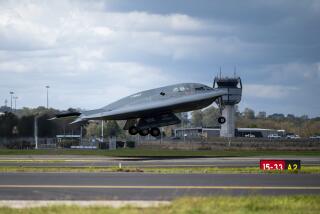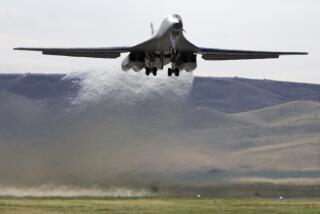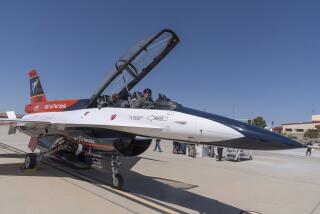Stealth Bomber Controversy
- Share via
The column by Gen. John T. Chain Jr., commander in chief of the Strategic Air Command, who argues for development of the B-2 bomber, is a disturbing one (“A Bomber for the 21st Century, Today,” Op-Ed Page, July 24). After nearly a decade of keeping the B-2 budget under secret wraps he and the Air Force have brought it out of the “black program” closet so that the U.S. may “reap the benefits of long years of effort, expense and bipartisan support.”
Isn’t it curious that once the price tag and intended mission for the plane were opened to public scrutiny, the bipartisan support faded, the price tag showed we can ill-afford the bomber and the “long years of effort” depicted a nearly two-year delay in a program that is managed by a contractor under federal indictment for fraud, waste and abuse of taxpayers’ money?
We don’t need a manned Stealth bomber. Gen. Chain notes the bomber is favored because we can recall it, making it a more stabilizing threat than the ICBM. True, but existing bombers equipped with low-cost unmanned cruise missiles can be recalled, and if unleashed can strike their targets from standoff ranges of several thousand miles. The Soviets have admitted that they are fearful of the cruise missiles which can be launched in droves and are hard to detect, track and shoot down. Carrying a new stealth cruise missile sounds like a good role for the $28 billion worth of B-1Bs that we just finished paying for.
Even with stealth capabilities, it’s unlikely that the B-2 will be able to penetrate the Soviet motherland without the crew being overcome by radiation, heat and nuclear pulses. And even if they made it there, who is going to be around to tell them which targets to strike after the first wave of an ICBM attack? As a nation we are preoccupied with posturing ourselves to fight a nuclear war with the Soviets, a highly unlikely scenario, when we should focus our attention on beefing up conventional forces and countering Third-World belligerents.
While the B-2 is a neat looking plane with the latest technology, it’s no bargain for the nation at some $500 million per plane and adds nothing to the triad of bombers, ICBMs and sea-launched ballistic missiles. With SLBMs and ICBMs we can strike hardened Soviet targets--including command and control centers--with pinpoint accuracy. Putting a fleet of 132 B-2 insurance policies costing $70 billion on the Tarmac will not buy us more deterrence, it will just buy us more debt. We should be spending our defense dollars on building up our conventional forces and weapons and in capabilities to counter terrorism and regional wars.
Several weeks ago an Air Force colonel involved in policy and planning at the Pentagon told me, after a series of highly classified meetings on strategic systems, “The B-2 is dead, you heard it here first.” If that’s the case, and it should be, may we let the Spruce Goose of the Reagan years rest in peace.
JAMES B. SCHULTZ
Moorpark
More to Read
Get the L.A. Times Politics newsletter
Deeply reported insights into legislation, politics and policy from Sacramento, Washington and beyond. In your inbox twice per week.
You may occasionally receive promotional content from the Los Angeles Times.










